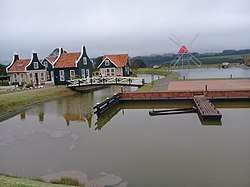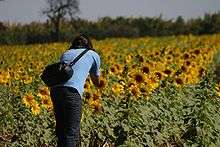Dutch Brazilians
Dutch Brazilians (Portuguese: Neerlando-brasileiro) refers to Brazilians of full or partial Dutch ancestry. Dutch Brazilians are mainly descendants of immigrants from the Netherlands.
| Total population | |
|---|---|
| 11,000 [1] | |
| Regions with significant populations | |
| Predominantly Northeast Region, South Region and Southeast Region[2][3][4] | |
| Languages | |
| Portuguese, Dutch | |
| Religion | |
| Roman Catholicism, Protestantism | |
| Related ethnic groups | |
| Dutch people, Flemings, Frisians, White Brazilians |

The Dutch were among the first Europeans settling in Brazil during the 17th century. They controlled the northern coast of Brazil from 1630 to 1654. A significant number of Dutch immigrants arrived in that period. The state of Pernambuco (then Captaincy of Pernambuco) was once a colony of the Dutch Republic from 1630 to 1661. There are a considerable number of people who are descendants of the Dutch colonists in Paraíba (for example in Frederikstad, today João Pessoa), Pernambuco, Alagoas and Rio Grande do Norte.[5][6]
During the 19th and 20th century, Dutch immigrants from the Netherlands immigrated to the Brazil's Center-South, founded a few cities and prospered.[7] The majority of Dutch Brazilians reside in Espírito Santo, Paraná,[2] Rio Grande do Sul and São Paulo.[3] There are also small groups of Dutch Brazilians in Goiás, Ceará, Rio Grande do Norte, Mato Grosso do Sul, Minas Gerais and Rio de Janeiro.[4]
Dutch presence in Brazil
The Dutch West India Company was established in Amsterdam in 1621 and soon came into contact with the overseas domains of Portugal and Spain. The Dutch had already visited Brazil's coast, and possession of its brazilwood and sugar became an object of interest of the new company. By 1630, the Dutch occupied Pernambuco establishing the colony New Holland and gradually expanded their conquests to Ceará and to the north into Rio Grande do Norte.
| Historical population[8][9] | |
|---|---|
| Period | Total |
| 1640–46 | 15,000 |
| 1654 | 20,000 |
In 1637, Count Johan Maurits of Nassau-Siegen (1604–1679) arrived in Recife, the captaincy (a political and administrative division of colonial times) of Pernambuco, to become the first Dutch governor. He was assigned by the Dutch West India Company to consolidate the Dutch settlements and economic interests in Brazil. The Count was a good administrator of the city and of Dutch interests in general. His government was characterized by the inclusion of men of distinguished learning, among them painters such as Albert Eckhout (1637–1664) and Frans Post (1612-ca.1680), as well as naturalists such as Zacharias Wagner (1614–1668), who documented Brazil's flora and fauna. In 1647, Count Maurits' biographer, Gaspar Barleus (1584–1648), wrote Rerum per Octennium in Brasília (History of Deeds Done in Eight Years in Brazil), considered the most important work about colonial Brazil.
| Mauritsstad population (1650)[10] | |
|---|---|
| Total | 8,000 |
| Ameridians and Negros | 3,000 to 4,000 |
| Vrijburghers | 3,400 |
| Jews | 600 |
The Luso-Brazilian population living in northeastern Brazil, the area under Dutch control from 1624 to 1654, resisted at first but later submitted to the control of the Dutch. After Count Johan Maurits left Brazil, the population rebelled against the Dutch. In 1648-49 the Luso-Brazilians defeated the Dutch in the first and second battles of Guararapes, and gradually recovered their control over the region. In addition, the wars between England and the Dutch Republic were weakening Dutch power everywhere. In January 1654 the Dutch surrendered and signed the Treaty of Taborda, but only as a provisory pact. By May 1654 the Dutch Republic demanded the colony back. On 6 August 1661 New Holland was formally ceded to Portugal through the Treaty of The Hague.
Even though Dutch rule in northeastern Brazil was relatively brief, it left an indelible mark on the architecture and art history of the region. Depictions by Dutch painters of the new country and its spectacular natural life were among the first such portrayals to be shown in Europe.
| Haplogroup 2 among White Brazilians[11] | |
|---|---|
| Location | % |
| Brazil | 19 |
| South Region | 28 |
| Northeast Region | 19 |
| North Region | 14 |
| Southeast Region | 12 |
In addition, the Dutch founded the first synagogue in the Americas, Kahal Zur Israel Synagogue - [12] in Recife in 1636.[13]
Colonial reports stated that there was a strong rate of miscegenation between Amerindians, Portuguese, Blacks, Jews, Dutch, Germans, French and Englishmen during the period of the Dutch Brazil colony.[14] The majority of soldiers and marines who lived in the Nieuw-Holland were Dutch, Germans, Norwegians, Scottish and Jews.[15] The absence of women in the colony explained the high rate of mixed race people.[16]
In 2000, a genetic study among white Brazilians showed that 19% of people born in the Northeast had a genetic marker for chromosome Y that is common in Europe (haplogroup 2 - corresponding today to the sum of haplogroups I, G an J). This shows an excess of 6% when compared to Portugal (13%). The other Brazilian region which also has a higher frequency than Portugal is the South Region (28%). According to the research, the excess in both regions could be explained as due to the strong European immigration in the South Region and the Dutch presence in the Northeast. Another study showed a higher contribution of European ancestry in chromosome Y among people from the Northeast Region, Brazil (94,74%) when compared with samples from Southeast Brazil (85,88% - 88,1%).[17][18]
The second wave
The first Dutch immigrants to Brazil went to the state of Espírito Santo between 1858 and 1862, where they established the settlement of Holanda. This settlement of five hundred mainly Reformed folk from West Zeeuws-Vlaanderen in the province of Zeeland was not successful. All further immigration ceased and contacts with the homeland withered. The "lost settlement" was only rediscovered after one hundred and ten years, in 1973. Except for the Zeeuwen in Holanda, Brazil attracted few Dutch until after 1900. From 1906 through 1913 over 3,500 Dutch emigrated there, mainly in 1908–1909.
After the Second World War, the Dutch Organization of Catholic Farmers and Vegetable Growers (KNBTB) coordinated a new flow of Dutch immigrants in search for a new life and new opportunities in Brazil. The most known Dutch settlements in Brazil are Holambra I and Holambra II (because they became leading producers of flowers), but other settlements were established as well, and in time these small villages became cities.
Also arrived after Second World War were Eurasian refugees of mixed Indonesian and Dutch blood called Indos. These Indos traveled to Brazil because the Dutch society did not consider their war experience in Indonesia, and did not recognize the European status the Indos held dearly in their mother country.[19] The number of Indos in Brazil was never counted because they are a part of the overall Dutch-Brazilian population.
Colony of Holambra
Holambra is a municipality in São Paulo. The colony Holambra (from the words Holland-America-Brazil) and The Cooperativa Agropecuária de Holambra (Cattle Farming Cooperation of Holambra) were founded in 1948 by Catholic Dutch immigrants at the farm Fazenda Ribeirão, situated between the cities Jaguariúna, Santo Antônio de Posse, Artur Nogueira and Cosmópolis. After a referendum in 1991 where 98% of the population voted in favor of political autonomy for the area, Holambra gained city status in January 1993.
The cows that were shipped in from the Netherlands by the initial colonists did not survive the heat and tropical diseases so the colonists diversified to pig and chicken farming. As the colony around the farm grew in the following decades, the focus shifted from agriculture to horticulture. Famous for its large production of flowers and plants and for the yearly event Expoflora, Holambra receives ten thousands of tourists each year. In April 1998 this fact was recognized as Holambra gained the status of Estância Turística, touristic location.[20]
Notable Dutch Brazilians
Dutch-descended families in Brazil are used to be celebrated in politics and culture:
- Aurélio Buarque de Holanda Ferreira - lexicographer, philologist and translator
- Bebel Gilberto - singer and composer
- Chico Buarque - singer, musician, composer, writer and poet
- David Neeleman - businessman
- Gilberto Freyre - cultural anthropologist, historian, journalist and congressman
- Djavan - singer and composer
- João Maurício Vanderlei, Baron of Cotejipe - former Prime Minister of Brazil
- José Wilker - actor and director
- Lobão - singer, songwriter, multi-instrumentalist and writer
- Mariana Ximenes - actress
- Nelson Piquet, Jr. - racing driver
See also
- Barbadian Jews
- Dutch Brazil
- Dutch people
- White Brazilians
References
- "Dutch in Brazil". joshuaproject.com.
- "Cidades preservam tradições dos colonos" [Cities preserve traditions of colonists] (in Portuguese). Bem Paraná. 20 September 2007. Retrieved 14 April 2016.
- "Imigrantes: Holandeses". Terrabrasileira.net. Archived from the original on 29 April 2008. Retrieved 30 August 2017.
- "Imigração Holandesa no Brasil. Glossário. História, Sociedade e Educação no Brasil - HISTEDBR - Faculdade de Educação - UNICAMP". Histedbr.fae.unicamp.br. Archived from the original on 6 August 2013. Retrieved 30 August 2017.
- "Brasileiros na Holanda -". Brasileirosnaholanda.com. Retrieved 30 August 2017.
- "Agência CT - Ministério da Ciência & Tecnologia". Agenciat.mct.gov.br. Archived from the original on 7 May 2016. Retrieved 30 August 2017.
- "Holandeses no Brasil - Radio Nederland, a emissora internacional e independente da Holanda - Português". Parceria.nl. Archived from the original on 23 February 2009. Retrieved 30 August 2017.
- MELLO, José Antônio Gonsalves de. “Um ministro da igreja calvinista no Recife Holandês: o espanhol Vicente Soler 1636–1643”. In Revista da Universidade de Coimbra. Coimbra, v. 30, p.9, 1983.
- CANABRAVA, A. P. “História econômica: estudos e pesquisas ”. UNESP. São Paulo, p.75, 2007.
- "The Dutch in Brazil - Colonial Voyage". Colonialvoyage.com. Retrieved 30 August 2017.
- "GENÉTICA: RETRATO MOLECUL" (PDF). Laboratoriogene.info. Retrieved 30 August 2017.
- Jewish community in Recife (in Portuguese). Recife, Brazil: Jewish press. 2006. ISBN 85-240-3919-1. Archived from the original (PDF) on 2006-10-18. Retrieved 2007-07-18.
- "United States and Brazil: The Defeat of the Dutch / Brasil e Estados Unidos: A Expulsão dos Holandeses do Brasil". lcweb2.loc.gov. Retrieved 30 August 2017.
- HALLAM, Paul. The book of Sodom. Verso. London, p. 204, 1995.
- MACHADO, Luiz Toledo. Formação do Brasil e da unidade nacional. IBRASA, São Paulo, v.1, p.29, 1980.
- MARCOS GALINDO, Luis Sávio de Almeida. Indios do Nordeste: temas e problemas : 500 anos, Volume 2 UFAL, Maceió,v.2, p.59, 1999.
- FIGUEIREDO, Raquel de Freitas. Estudo de SNPs do cromossomo Y na população do Estado do Espirito Santo, Brasil. 2012. 66 f. Dissertação (mestrado) - Universidade Estadual Paulista, Faculdade de Ciências Farmacêuticas, 2012.
- "Estudo de SNPs do cromossomo Y na população do Estado do Espirito Santo, Brasil". Base.repositorio.unesp.br. Retrieved 30 August 2017.
- "Dutch immigration". Oplanob.com.br. Archived from the original on 21 February 2009. Retrieved 30 August 2017.
- "Holambra, Brazil". Creekin.net. Archived from the original on 8 April 2008. Retrieved 30 August 2017.
External links
- Dutch Association of Rio de Janeiro (in Dutch)
- Dutch Society of São Paulo (in Portuguese)

